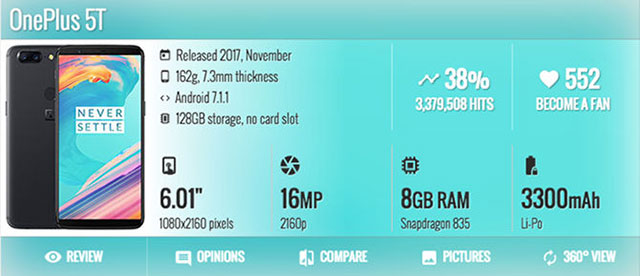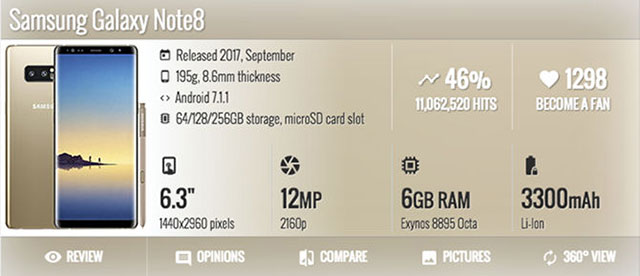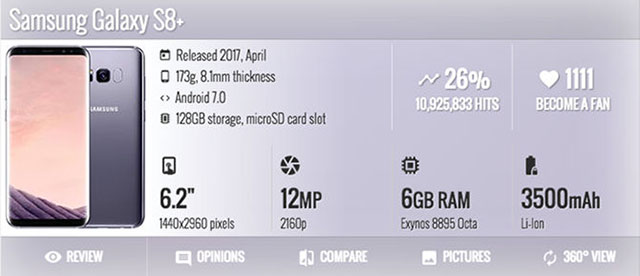This is why iOS has less RAM than Android
The battle between iOS and Android until today is still in the eight-pound half-pound position. Obviously there are certain reasons why you choose one side or the other, but that doesn't stop us from continuing to compare.
One thing you may not notice, iOS phones often consume less RAM than Android machines to half or more. But why is that? Today's article will give you the answer.
Compare RAM of iPhone and Android
Compare some high-end Android devices from many brands including OnePlus 5T, Galaxy Note 8, S8 + and Google Pixel 2XL with iPhone 8, 8 Plus and iPhone X.




Android high-end phones all use 6 to 8 GB
These are the top 4 phones in 2017 in the Android world, the RAM parameters are very high and if you want to upgrade it also costs a lot of money (from $ 650 to $ 1000). Most Chromebooks are only 4GB, only a few have 8GB versions, and even those are cheaper than Android phones.
Although only the OnePlus 5T has 8GB of RAM, there must be a reason that Android generally needs so much RAM. What if compared with iPhone?



Meanwhile, the iPhone only needs about half of Android's RAM
You probably already see it. The most sluggish "iPhone" in 2017 is the iPhone 8 with only 2GB of RAM, the iPhone 8 Plus with 3GB and even the latest iPhone X, the best is only 3GB.
Looking ahead a bit, this is not surprising. iPhone 7 Plus of 2016 also has only 3GB. iPhone 7, 6S Plus and 6S run 2GB no problem, iPhone 6 still runs iOS 11 and only 1GB RAM.
Why can iPhone 6 of 2014 be able to run the latest iOS version with only 1GB of RAM and Android devices need up to 8 times more RAM?
Why does Android phone need so much RAM?
From the beginning, Android was designed to support many types of processors, many manufacturers and many ways to tweak different components. Typically, software written for a certain system cannot run on another system but must switch (port), usually rewriting incompatible bits.
Android apps often run on Java. Java is convenient because you only need to write the application once on Java then the virtual machine will "translate" that code on the runtime environment to run on other systems.
But this also has its price.
Java virtual machines are very complex and costly, not only managing processes on virtual machines but also keeping the original Java code of the application and the code after being translated to run on the system.
On the one hand, virtual machines on Android have been improved for many years and do not need much RAM as before. But on the other hand, Android apps are also getting more complex and need more RAM. RAM is also needed for background processes that are very popular on Android applications.

Android consumes more RAM than iOS, so more RAM is needed
Finally, Android is built on a method called 'garbage collection'. Android apps are encouraged to use as much RAM as possible. Android will then clean up a body on RAM all the unused data (junk) for other applications to use. This will work when the machine has a lot of RAM, otherwise the system will lose a lot of time to clean up the garbage.
So if you use Android, it should be 4GB RAM to have good speed. If not then at least 2GB .
- 8 easy ways to free RAM make the machine run faster
- Free your computer RAM with just 4 effective commands
Why doesn't iOS consume RAM like Android?
Apple controls its iOS ecosystem much tighter. If you use iOS, you only have one option, iPhone. If you want to create an iOS app, you must use Apple's tools and play according to Apple's law.
This has its own advantages.
Apple knows exactly the parameters of each device running its OS so it can make design decisions. For example, Android needs to support multiple processors, iOS only runs ARM.
Therefore, iOS does not need a virtual machine to translate immediately and always like Android. All applications are compiled in native code, executed right on the hardware. Without a virtual machine, it also means that you need more RAM.
iOS is also thinking about managing other memory. While the Android OS itself manages memory, on iOS, this is for apps. Instead of allowing the app to take up more RAM and free up when not in use, the iOS app automatically allocates memory when needed.
iPhone with less RAM doesn't mean it will run slower. So many times looking at the specifications is not enough to say anything.
See more:
- Which screen parameters are completely meaningless?
- Is it true that Android costs more RAM than iOS?
- RAM & ROM: two concepts are easily confused
You should read it
- 4 ways to uninstall apps for Android devices
- Good tips for Android devices
- Instructions for finding the Android phone model (line) you own
- List of devices to be Android 8 - Android O of Samsung, Huawei, LG, Oppo, Sony and HTC
- Check Android phone configuration
- All you need to know about Android Pie
- Is it true that Android costs more RAM than iOS?
- Instructions from AZ how to block calls and messages on Android Nougat
May be interested
- The best top 7 Android TV box
 many manufacturers have taken advantage of google's open-source android operating system to build set-top boxes of all shapes and sizes.
many manufacturers have taken advantage of google's open-source android operating system to build set-top boxes of all shapes and sizes. - What is Android ROM? Three things to know about Android ROM
 you may already know rom stands for read-only memory, but it has a completely different meaning in the android world. on android, rom means the operating system running on your device. let's learn about the basic rom information with tipsmake.
you may already know rom stands for read-only memory, but it has a completely different meaning in the android world. on android, rom means the operating system running on your device. let's learn about the basic rom information with tipsmake. - Is it true that Android costs more RAM than iOS?
 one of the most controversial questions between the two most popular mobile operating systems in the world, android and ios. when looking at the configuration of iphone phone models and android flagship models, you can easily realize that iphone is often equipped with less ram than iphone ...
one of the most controversial questions between the two most popular mobile operating systems in the world, android and ios. when looking at the configuration of iphone phone models and android flagship models, you can easily realize that iphone is often equipped with less ram than iphone ... - What is Android Studio?
 there are many tools to develop android, but now the most powerful and official tool is android studio. this is the official ide for the android platform, developed by google and used to create most applications that you can use on a daily basis.
there are many tools to develop android, but now the most powerful and official tool is android studio. this is the official ide for the android platform, developed by google and used to create most applications that you can use on a daily basis. - 11 little-known Android tips to make your life easier
 one big reason people buy android phones is the versatility that the operating system offers. you will be surprised how much you can improve your user experience by changing a few settings.
one big reason people buy android phones is the versatility that the operating system offers. you will be surprised how much you can improve your user experience by changing a few settings. - 6 useful Android settings you may not know yet
 as an android user for many years, many people may think that they know quite well about the android settings menu. however, there are some useful settings that users can ignore or not know about.
as an android user for many years, many people may think that they know quite well about the android settings menu. however, there are some useful settings that users can ignore or not know about. - List of phones eligible for Android 12 Beta upgrade from today
 google has officially launched android 12 with a major overhaul of the interface, improved smoothness and privacy. what android users look forward to the most right now is to update the new operating system experience.
google has officially launched android 12 with a major overhaul of the interface, improved smoothness and privacy. what android users look forward to the most right now is to update the new operating system experience. - A picture worth pondering about the Android world today
 many android phone users may be annoyed because apps are often available on google play store slower than iphone users. however, this annoying story comes from a quite distant cause and is also the biggest problem of android today, which is fragmentation.
many android phone users may be annoyed because apps are often available on google play store slower than iphone users. however, this annoying story comes from a quite distant cause and is also the biggest problem of android today, which is fragmentation. - List of devices to be Android 8 - Android O of Samsung, Huawei, LG, Oppo, Sony and HTC
 android 8 or android o is the latest android version of the world's most popular operating system on the current smartphone from google developer ... the following is a list of certain devices or can be uploaded to android o during the time next time!
android 8 or android o is the latest android version of the world's most popular operating system on the current smartphone from google developer ... the following is a list of certain devices or can be uploaded to android o during the time next time! - The whole technology world guessed the wrong name of Android L?
 what is the last name of android l? perhaps only google knows, but if the company goes silent, many people will probably be rumored from a google artwork provider, giovanni calabrese, who is bewildered by the name he has just revealed.
what is the last name of android l? perhaps only google knows, but if the company goes silent, many people will probably be rumored from a google artwork provider, giovanni calabrese, who is bewildered by the name he has just revealed.










 This is why Alexa will dominate every smart home
This is why Alexa will dominate every smart home Following the trail of Internet Explorer 6, does Google Chrome fail?
Following the trail of Internet Explorer 6, does Google Chrome fail? How to shoot 4K video, using VR, AR without this?
How to shoot 4K video, using VR, AR without this? Facebook's new privacy policy raises questions
Facebook's new privacy policy raises questions Apple 'home' chip manufacturing journey, threatening rulers Qualcomm and Intel
Apple 'home' chip manufacturing journey, threatening rulers Qualcomm and Intel This is how technology shapes education in the future
This is how technology shapes education in the future